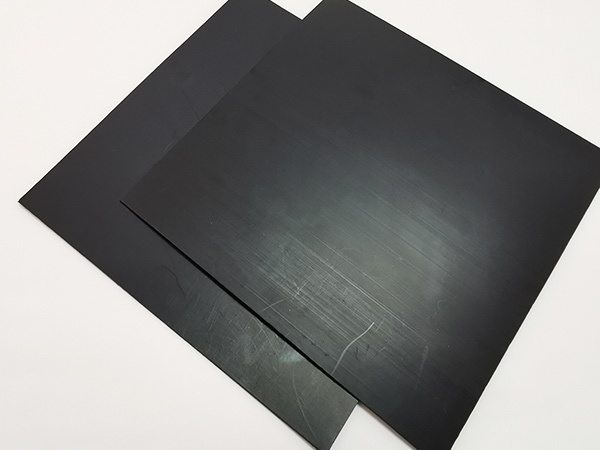What is the difference between HDPE and LLDPE geomembrane?
Release time:
2024-06-07
In summary, the choice between HDPE and LLDPE geomembranes largely depends on the specific project requirements, including the need for chemical resistance, flexibility, temperature exposure, and installation considerations.
HDPE (High-Density Polyethylene) and LLDPE (Linear Low-Density Polyethylene) geomembranes, while both belonging to the polyethylene family, exhibit different properties that make them suitable for specific applications. Here's a comparison of their characteristics:

HDPE Geomembrane:
1. Density: As the name suggests, HDPE has a higher density compared to LLDPE, resulting in a more rigid structure. This gives HDPE geomembranes better tensile strength and puncture resistance.
2. Chemical Resistance: HDPE generally offers superior chemical resistance, making it more suitable for environments exposed to harsh chemicals, solvents, or acids.
3. Temperature Resistance: HDPE geomembranes can withstand a wider range of temperatures without significant deformation, making them more suitable for applications in extreme climates.
4. Installation: Due to its higher stiffness, HDPE geomembrane might require more care during handling and installation, especially in cold weather when it becomes less flexible.
5. Cost: Historically, HDPE geomembranes have been less expensive than LLDPE, although this can vary depending on market conditions and specific product formulations.

LLDPE Geomembrane:
1. Flexibility: LLDPE geomembranes are more flexible and elongation resistant than HDPE. This increased flexibility makes them easier to install, especially over uneven surfaces, and they are less prone to cracking in cold weather.
2. Impact Resistance: LLDPE offers better impact resistance and tear resistance, which can be beneficial in applications where there is a risk of physical damage from rocks, roots, or heavy equipment.
3. Weldability: LLDPE geomembranes are often considered easier to weld due to their lower melting point, which can lead to faster installation times and potentially fewer defects.
4. Chemical Resistance: While still providing good chemical resistance, LLDPE is generally less resistant to certain chemicals compared to HDPE, making it less suitable for applications involving highly corrosive materials.
5. Cost: Depending on the specific grade and application requirements, LLDPE geomembranes might be more expensive than HDPE, reflecting their enhanced flexibility and ease of installation properties.
In summary, the choice between HDPE and LLDPE geomembranes largely depends on the specific project requirements, including the need for chemical resistance, flexibility, temperature exposure, and installation considerations. Both materials offer reliable containment solutions but excel in different aspects, making them tailored for diverse applications across industries.
Latest News
Exploring the Benefits of Biogas Digester Geomembranes from China
Biogas digesters are essential components in the conversion of organic waste into renewable energy. A critical element of these systems is the geomembrane, a high-performance barrier that plays a vital role in ensuring the efficiency and sustainability of biogas production. Biogas digester geomembranes from China are particularly noteworthy due to their durability, cost-effectiveness, and versatil
2025-11-12
Discover the Advantages of Premium Dam Liner Geomembranes in Construction Projects
Discover the Advantages of Premium Dam Liner Geomembranes in Construction Projects Table of Contents 1. Introduction to Dam Liner Geomembranes 2. What Are Dam Liner Geomembranes? 3. Advantages of Using Dam Liner Geomembranes in Construction 3.1 Durability and Longevity 3.2 Excellent Waterproofing Capabilities 3.3 Cost-Effectiveness and Efficiency 3.4 Reduced Environmental Impact 4. Applications
2025-11-09
Everything You Need to Know About Customized Tunnel Waterproofing Geomembranes
--- Customized tunnel waterproofing geomembranes are specialized materials designed to prevent water infiltration in tunnel construction projects. These geomembranes play a crucial role in ensuring structural integrity and longevity by effectively managing groundwater and preventing water-related damages. In this article, we will delve into the key features, applications, and benefits of these cus
2025-11-06
Advantages of New Reservoir Liner Geomembrane in Construction Projects
The incorporation of new reservoir liner geomembrane technology in construction not only enhances project efficiency but also promotes sustainability and environmental protection
2025-11-03
Understanding the Importance of Famous Waste Containment Geomembranes in Construction
Geomembranes are impermeable membranes used to control fluid or gas migration in a variety of applications, including waste containment. When we refer to 'famous waste containment geomembranes,' we are discussing high-performance materials that have gained recognition for their effectiveness and reliability in managing waste and protecting the environment. One of the primary functions of waste con
2025-10-31
Exploring the Benefits of Classy Irrigation Canal Geomembrane for Sustainable Landscapes
Classy irrigation canal geomembranes represent a pivotal advancement in sustainable landscaping and irrigation practices. By offering significant benefits such as water conservation, soil protection, and eco-friendly solutions
2025-10-28




